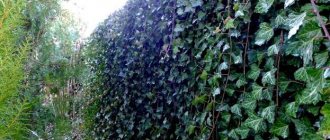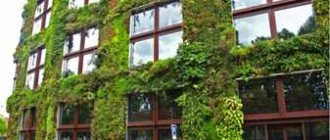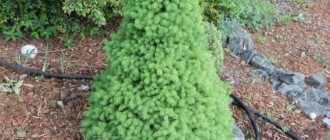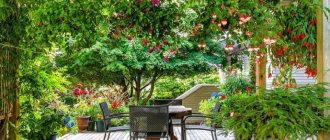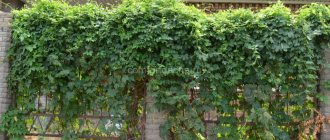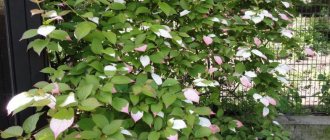Perennial
Before considering each type of climbing plant separately, you should understand the selection parameters.
To make a hedge pleasing to the eye, select young plants taking into account climate, humidity, light, soil composition - these are the most important parameters that guarantee you the most optimal selection. An important nuance is the fence itself. Thin and flimsy will not withstand heavy large vines. Self-clinging plants will not be able to climb on brick; you will have to make garters.
Advice! Do not plant several different species close to each other. You should especially be wary of ivy and hops - they will simply outlive decorative and more demanding neighbors.
Ivy
This climbing plant does not care where it grows, so it is often used in landscape design. Garden ivy survives in both hot sun and cool shade. At the same time, it grows and becomes a beautiful hedge in just a couple of months.
The plant is perennial, you will only have to tinker in the first year - the older the ivy gets, the less attention it requires. From the second year, the gardener's main task will be regular watering and pruning 2-3 times per season.
The photo shows an example of ivy growth
Hop
An excellent choice for those who do not like to care for plants, but want to decorate the garden with climbing plants for the fence. Large juicy leaves, fast growth, beautiful entwining of the fence - with hops this is guaranteed. In July-August the plant blooms profusely, and fragrant light cones are formed in place of the peduncle.
Important! Please note that getting rid of these two plants (hops, ivy) is incredibly difficult: digging or pulling them out is not enough; most likely, new shoots will appear from the ground for several more years.
Clematis
Maiden grapes
Let's start with the most simple perennial shrub vines.
There is nothing easier than growing virgin grapes. In the spring, cut lignified cuttings are planted in fertile, loose soil, watered regularly, supports are placed - and that’s it! After a couple of months, the rooted cuttings produce new shoots, which in a few years will completely cover the fence or wall of the house. Formative pruning needs to be done annually. This vine grows very quickly, climbing to great heights, but has an impressive mass, so the support must be strong. A very beautiful type of maiden grape - triacid - does not overwinter here, and the variegated form of the common one grows very slowly, so one cannot count on a quick effect.
Annuals
Not all climbing plants tolerate frost successfully. If you live in a harsh climate, choose fast-growing annuals for the role of climbing plants for the fence.
Sweet pea
It will help to refine the fence and decorate decorative partitions, but it should be taken into account that it reaches only 2-3 meters in height. Grows in any conditions except wetlands. After planting, the plant requires regular standardized watering, high-quality fertilizing and special supports - otherwise it will simply crawl along the ground, occupying the area horizontally.
There are a large number of varieties of sweet peas - they differ mainly in the color and aroma of the buds.
The photo shows weaving climbing peas with shoots
Decorative beans
A light- and heat-loving climbing plant for a fence. Beans are distinguished by their decorative juicy greenery, which is why gardeners love them. It does not require special care, but for more lush growth and abundant landscaping, nitrogen fertilizers can be used.
Also take into account her love for watering: the hotter it is outside, the more often the hedge is watered, up to a daily repetition.
Advice! The fruits of decorative beans can be collected and even eaten - to make more of them, the shoots are regularly pinched.
morning glory
Climbing and semi-climbing (rambler) roses
Climbing roses are remarkably beautiful, but very capricious. More often on sale there are semi-climbing, or rambler, with long, strong, non-climbing shoots that bloom once or repeatedly on last year's or current shoots. It is advisable to know all these characteristics about that variety. which you bought. Their winter hardiness varies greatly depending on the variety. Thus, the old variety Flammentanz, which blooms once with bright red flowers on last year’s shoots, is quite winter-hardy and has been blooming for me for many years. Many others gradually froze to death, some were eaten by mice in winter.
For the winter, the shoots of these roses are gradually bent and tied to a peg, the leaves are torn off, wrapped with a mosquito net from top to bottom so that mice do not eat them, and in late winter, when the temperature drops to minus 7 degrees, the base of the bush is covered with 2-3 buckets of loose compost soil. In the spring, they unplant the bush, but do not rush to lift it, because... Return frosts can severely damage green leaves. They are raised only when new shoots have already appeared on the plant. Old branches of three to four years of age are cut out almost to the base in the spring. The recently appeared Canadian climbing roses inspire us with cautious optimism; they are unlikely to winter much better. And they bloom very profusely all summer long.
We looked at shrubby perennial vines. Their advantages are very powerful growth, abundance of foliage and often beautiful flowering, but the disadvantage is the possibility of freezing in winter. Subshrubs and herbaceous perennial and annual vines do not have this disadvantage.
Winter-hardy
The evergreen climbing perennials from the first section survive even harsh winters without loss, but there are other options.
Honeysuckle
Ornamental species, such as honeysuckle, climb beautifully and bloom profusely throughout the season. But they have a drawback: the berries of these varieties (unlike shrubs) cannot be eaten, they are poisonous - so you should not plant them in an area where children can reach the fruits. Mature plants tolerate frosts without problems; they are not even removed from their supports. Young ones (up to 2-3 years) are best removed and covered at the end of the season.
Honeysuckle loves moist soil, so it is better to mulch the surface after planting to retain moisture. It grows best in the sun; the darker it is, the slower it will develop and bloom less.
Woodplier
As the name implies, this vine has more than enough strength and desire to live: without control, it will quickly kill other plants from the area and take over the territory. But with timely pruning, a hedge, even based on a picket fence or chain-link mesh, looks very decorative.
The tree plier survives the winter without much loss; you should not worry even if some of the shoots freeze. Thanks to its powerful root system, it will quickly recover with the arrival of warmer weather.
In the photo there is a wood plier entwined around an arch
Chinese lemongrass
This type of hedge has nothing to do with citrus fruits; the name was given solely because of the pleasant aroma of the fruit. Schisandra takes root and winters even in Siberian and Far Eastern territories, not to mention the mild winters of the central part of Russia. The only thing to keep in mind is that it does not like the sun, but it is ideal for decorating the shaded side of the fence.
Important! Schisandra stems are dried and brewed as tea - this drink has a restorative, energetic effect. Increases blood pressure, can even replace coffee.
Schisandra chinensis
Among the most winter-hardy vines, we can mention Chinese lemongrass. It is not decorative enough in spring and summer. Although it blooms profusely, it has small white flowers with a delicate aroma. Only in autumn does lemongrass begin to be decorated with long clusters of bright red berries and yellowing foliage. Schisandra is also valued for its healing properties - it has a tonic effect, as well as for the lemon scent of leaves and berries that are added to tea. Schisandra prefers loose, moisture-absorbing soil in partial shade, with strong support. Under good conditions it reaches a height of 15 m. In the first years it grows slowly, expanding the root system. It is better to remove the shoots - this promotes more abundant flowering
Plants with flowers
climbing rose
Suitable for experienced gardeners and those who are ready to care for this complex plant. Thorny shoots with flowers require careful handling and timely garter. But if everything is done correctly, during the flowering period the site will turn into a real imperial garden. It can overwinter, but in the fall it is wrapped and covered. Although even such a scenario does not guarantee a successful winter for the climbing rose.
The photo shows a profusely blooming rose
Important! Climbing roses are more susceptible to attack by aphids and spider mites than others. Carefully monitor the health of the seedling; timely measures taken when pests are detected will save the life of the plant.
Kobeya
In fact, the plant itself is a perennial and in the southern regions it blooms successfully for several years after planting. But it cannot be classified as winter-hardy, so in most of Russia it is grown as an annual - it grows quickly, blooms in the first year, and is suitable for decoration.
The leaves are quite large and beautiful, but kobeya is loved not for them, but for its charming bell-shaped flowers. There is no need for tying; the vine releases tendrils and grabs the support with them, climbing up on its own. Loves sunlight, can grow in partial shade, but not in dark areas.
The photo shows an example of a kobei garter
Nasturtium
Let the sun into your summer cottage: plant the original nasturtium! Near the fence you will need additional lashes and garters along which the plant can climb up. To ensure juicy and long-lasting flowering, plant in a bright place - both open ground and tubs or boxes are suitable. The flowers are large, bright - orange, yellow, red. White or pastel shades are less common.
Wisteria
A beautiful design option for fences, arches, and gazebos. Large clusters of flowers in a fresh purple hue combined with green foliage give a charming look to even the simplest buildings. Wild varieties prefer the hot climate of the subtropics, but breeders have developed species that can survive cold temperatures down to -37C. Are you planning to grow wisteria on your property? Look for the varieties that are most suitable for your climate.
Tree pliers round-leaved
Among other shrubby perennial lianas, I would like to note such a liana, which is still rare in our country - the tree plier. The most winter-hardy in our country is the round-leaved tree plier. This plant is made decorative by large clusters of bright orange or yellow boxes with scarlet berries inside that open in autumn. The fruits hang on the tree all winter, and all summer the shoots are densely covered with small oval leaves, which turn yellow by autumn. In winter, the ends of even this species freeze slightly; other types of wood pliers are even less winter-hardy.
Choosing a liana for the garden
Bare, empty fences in the garden can easily be disguised as living decorations. Climbing perennials will help protect the area naturally and aesthetically from the prying eyes of neighbors, dust and dirt, and will also create a cozy space, ideal for relaxation. Fast-growing plants are an excellent choice for people who want to dramatically change the look of their garden or terrace in a short time.
Many vines are perennial, they are divided into 2 types:
- Deciduous. For example, hops, clematis. Every year they produce new shoots from the roots. In autumn, hops can reach 6 meters in length. Areas with southern exposure are best suited for such plants.
- Evergreen vines. They do not shed their leaves until winter, creating a curtain that is impenetrable to wind and sunlight. The most popular types of vines that do not shed their leaves until winter are: ivy, euonymus, and some types of honeysuckle.
Evergreen vines are very popular among gardening enthusiasts; thanks to them, even in the coldest months, the garden will not lose its charm. Once the flowers have faded and the leaves have fallen from the trees, the evergreen vines will continue to delight the eye, filling the space with color.
If you choose the right plants and take care of changing colors throughout the year, the garden will almost never fall into winter sleep.
Vines for sunny places, recommended for fences, arbors and shelving:
- clematis;
- climbing rose;
- girl's grapes;
- euonymus;
- honeysuckle;
- grape.
By planting a variety of plants near the fence, we will ensure that the color of the fence changes throughout the year, bringing the garden to life. You should also consider the vigor and weight of the plant. Very vigorous vines will quickly create cover, but will require heavy pruning in the future to prevent them from drowning surrounding plants or damaging supports.
The type of fence is also important: some plants can climb the wall, others cling to their tendrils or wrap them in mesh.
When choosing a seedling, you should not buy plants in too small pots whose roots grow above the ground or through holes in the bottom. They have probably already dried out, so there is a high risk that they will not take root after planting.
In colder areas of the country exposed to strong winds, it is better to plant a plant with increased frost resistance:
- in a shady place, instead of schizophragma, it is better to plant a similar petiole hydrangea;
- in full sun instead of a climber - fast-growing clematis of the Tangutica group;
- climbing evergreens such as ivy, euonymus fortunea, pointed honeysuckle and Japanese honeysuckle are moderately hardy.
The choice also depends on the lighting:
- in the bright sun, sun-protective plants are planted - knotweed, clematis);
- shade plant - ivy, hydrangea, schizophragma, kirkazon;
- Plants that are tolerant of sunlight (virgin grapes, woodworms), if planted in the shade, may lose their benefit in the form of autumn leaf color.
What to consider when creating a green fence
- In addition to providing high-quality support for the rapid growth of plants, it is necessary to remember about the lighting of the planting site. A shady place is suitable for honeysuckle, ivy, and climbing hydrangea, while grapes, hops and campsis prefer a sunny place.
- Different vegetation has different planting patterns. The recommended distance between grapes, hops or ivy is 30-50 cm, between honeysuckle and campisis from 1 to 1.5 m.
- The fence can contain a combination of different types of vegetation, for example, grapes and campis, hops and honeysuckle.
Romantic pink
Pink tones evoke a romantic mood. Most often they are used to highlight the sophisticated design of the garden. But the color comes in such an incredible number of shades that everyone will find a plant that can touch the strings of their soul.
What to plant?
If this is your favorite color, take the time and effort to grow Camellia x williamsii cultivar Debbie in a container. Her graceful pale pink heads decorating the spring garden are simply a hymn to tenderness and fragility.
Camellia in the spring garden
Of the vines that are more hardy and adapted to our climate, clematis varieties Elizabeth with large and fragrant flowers, Duchess of Albany with dark pink bells, and Francesca with delicate semi-double buds deserve a place in the rose garden.
Landscaping project from Sad-dizain
More details
Plant roses against a south wall or in a well-lit corner of the garden. The palette we need is represented by such proven varieties as Albertine, Constant Spry, Aloha, Francois Juranville.
Climbing rose Constance Spry will turn an ordinary gazebo into a romantic place for a date
Pink buds go well with plants blooming in crimson, dark blue, and white. But it’s better not to allow yellow and orange to coexist.
Calming white
The white color exudes purity. Unobtrusive and calm, it often recedes into the background, which is especially valuable in small gardens, as it allows you to visually expand the space. In addition, against the background of greenery, with beautiful decorative filling, it looks very formal and solemn.
What to plant?
And again clematis are in the lead. The first to bloom in spring is the evergreen clematis Armanda, variety Snowdrift. In beauty and sophistication it is not inferior to the Duchess of Edinburgh, which blooms a little later. Until the end of the season, the Alba Luxurians variety will delight the eye with large white flowers with a purple center.
White clematis will become an exquisite decoration of the front area
Near one of the northern walls you can plant a shade-tolerant petiolate hydrangea that blooms in large snow-white clusters.
If you need to quickly decorate your pergola, take a closer look at the climbing kobaea (Cobaea scandens). This is a perennial liana that we grow as an annual crop. Over the course of a year, it grows up to 4 m and is completely covered with large bells the color of white wine.
The list of welcome guests for a white garden includes roses, the unpretentious Aubert's fallopia (Fallopia aubertii), and wisteria of the Alba variety.
Kobeya can not only be directed upward, but also create stunningly beautiful flower carpets from it.
White can be combined with any colors and shades. The main thing is to avoid excessive diversity.
Differences in growth method:
- Creeping. They need support and a mandatory garter. Otherwise, they will be covered with a continuous carpet on the ground. I'm clinging to. They are attached to the frame independently, using extensions and antennas.
- Mountaineering. They can do without supports, securely clinging to the surface with their suction cup roots. Only the walls should be rough.
IMPORTANT: Before planting them, you need to think through and prepare the supports in advance. For some, tight and thin ropes are enough, while for others, durable structures made of wood or metal are needed.
Features of bindweed
Bindweed has a wide variety of life forms. In natural conditions, you can meet bindweeds, which are both perennials and annuals. They are subshrubs or herbaceous plants, their creeping or erect shoots reach 400 cm in length. Creeping rhizomes have thread-like roots. Alternately arranged whole simple leaf blades have petioles. They have a heart-shaped or arrow-shaped shape, and can also be jagged or lobed. The opening of flowers is observed in the early morning. They are placed in the axils in 1, 3 pieces or in inflorescences. The shape of the corolla is funnel-shaped or bell-shaped, while the blades are very slightly pronounced. The fruit is a capsule containing seeds, which remain viable for 2 or 3 years.
Ideal Living Fence With Flowers
